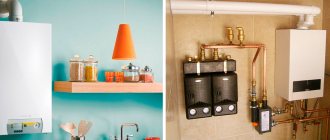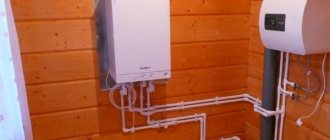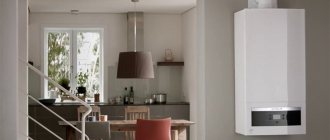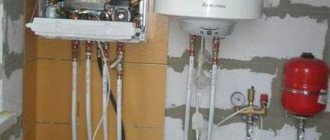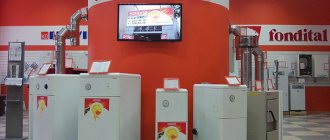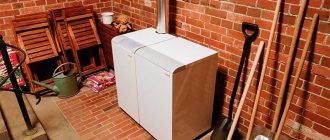In small households and country houses there is often a need to arrange a special room for gas equipment. As a rule, heating units in such buildings are located not in separate boiler rooms, but inside the house.
In this situation, it is best to use a wall-mounted gas boiler as a heat source. Such units are small in size, you can simply hang them on the wall in the kitchen, they will not interfere and will not worsen the appearance of the room.
Features of wall-mounted boilers
In terms of design features, gas boilers have much in common with heating devices operating on other types of fuel, but they also have differences.
Design
Wall heaters are a complex of sensors, instruments and devices assembled in one housing.
Units of this type have the following design:
- Gas-burner. It consists of several tubes with slot-shaped nozzles, assembled into a rectangular contour. This arrangement of nozzles promotes uniform and efficient combustion of gas.
- Combustion (combustion) chamber. Designed for gas combustion. It contains the burner and heat exchangers. It can be open or closed.
- Heat exchanger. It heats the liquid due to the heat generated by the combustion of gas. In the heat exchanger, water begins to move through the heat supply pipes.
- Circulation pump. Helps the coolant move in the heating system.
- Expansion tank. Carries out the selection of excess coolant when it is heated.
- Device for removing combustion products. In boilers with natural circulation, it is a pipe that connects the combustion chamber to the chimney. For turbocharged boilers, a coaxial pipe with a fan is installed, which removes exhaust gases.
- Electronic module. Using a set of devices and sensors, it controls the operation of the boiler according to the selected program. The built-in self-diagnosis system detects problems with the operation of the boiler and displays information about them on the display in the form of a code.
Advantages
A wall-mounted gas heating boiler has a number of advantages - this explains the increased demand for such models.
Pros:
- Compact and modern design. The unit does not require a separate boiler room.
- The use of a modulating burner and circulation pump provides higher efficiency compared to floor-standing models.
- High level of equipment autonomy. There is no need for constant supervision of its work.
Flaws
When operating wall-mounted units, there are some difficulties that must be taken into account.
Flaws:
- The need to obtain permits for the use of gas equipment.
- The devices do not work during a power outage.
- Relatively low power.
- Increased demands on the quality of the coolant compared to floor-standing models.
- High sensitivity to voltage surges.
- The need for a mandatory protective grounding device.
Who is it suitable for?
Gas heaters are used in places where there is access to a natural gas pipeline. The operation of gas equipment is much more comfortable and economical than the use of heating units using other types of fuel.
Currently, the power of wall-mounted models produced ranges from 12 to 42 kW, which is enough to heat private houses and apartments with an area of 30 to 500 m². If there is only a need for heating, you can choose a single-circuit unit.
In order to provide housing with hot water for domestic needs, many models of wall-mounted boilers with two heat exchangers are produced. The devices are compact and do not require a separate room for installation; their use is optimal for small private houses and apartments.
Equipment difference
The two boiler options mentioned above (single-circuit and double-circuit) are just enlarged characteristics of a wide range of gas equipment. They are taken as an example due to the fact that the installation of such a gas boiler can be done with your own hands. Other options for gas heating devices will require the involvement of professionals. Fortunately, now it’s not difficult to find a specialist for installation. They will prepare the room and complete the documentation.
Boiler for hot water supply
Such equipment is often called a “water heater”. At their core, they are actually simple in design. There is nothing except the heat exchanger and burner. To work, you need to connect a gas and water hose to it, and also equip a chimney. Nothing more will be needed. Of course, you should not forget about obtaining permits for connecting a gas boiler. Otherwise, there is a risk of receiving a serious fine.
Boiler room for home
Double-circuit gas equipment with automation is produced so well-developed that the installation process is exactly the same as for a simple water heater. The presence of automatic control is due not only to the ease of installation and installation. It is able to control the ambient temperature and adjust according to the necessary settings. During operation of such a boiler, gas consumption can be reduced by up to 70%.
But installing a gas boiler of this type has a significant drawback. If the power supply to the house is interrupted, the boiler will not work. At the same time, the circulating sediment, if present, will also stop working. You will have to take care of additional backup power supply. You can see how to choose the right electric generator here.
Types by camera type
Depending on the design of the combustion chambers, there are 2 types of boilers: open and closed.
Open
In this case, air intake to ensure the combustion process occurs from the room where the boiler is located. Such devices are also called atmospheric. Exhaust gases are discharged through the chimney.
To take in the required amount of air and ensure trouble-free operation of the boiler, a ventilation pipe is usually installed, located in the same casing as the chimney. The height of the structure must be higher than the cut level of the roof of the house. If ventilation is poor, there may be a lack of air in the room, so the pipes need to be cleaned regularly.
Closed
Gas boilers with a closed combustion chamber are also called turbocharged. The air required for combustion is taken from the street. Exhaust gases are discharged through a coaxial pipe.
This type of chimney is a structure of two pipes inserted into one another. Exhaust gases flow out through a pipe of smaller diameter, and fresh air flows through the gap between them.
Both processes occur using a fan, which is why such a system is called a supply system. Outside air enters the chamber where the gas is burned, already heated, which contributes to a higher efficiency of the boiler. The coaxial pipe simply comes out of the wall to the outside.
The use of boilers with a closed firebox significantly reduces the requirements for ventilation of the room where gas equipment is installed. One of the disadvantages of such units is the noise that the supply fan makes during operation.
The equipment is also more expensive compared to open models. But this disadvantage is compensated by the absence of the need to install chimney and ventilation pipes.
Burner
In most cases, burners are made in the form of tubes with holes through which gas mixed with air is supplied. The burner is designed to maintain the combustion process and its intensity. The burner can be atmospheric or forced. The second type can only work with a fan, so it is noisier. However, this option is more efficient, as it allows you to regulate the air supply. Atmospheric burners are characterized by longer operation, absence of vibration during operation, and complete combustion of gas.
Types by number of circuits
Wall-mounted units are divided into single- and double-circuit. The former are intended only for heating rooms, while the latter additionally heat water.
Single-circuit
A single-circuit boiler has one heat exchanger in which the liquid is heated using heat from the burned gas. It is located above the burner in the combustion chamber and consists of a coil pipe on which a ribbed box is placed.
The materials for the manufacture of such devices are:
- cast iron;
- copper;
- steel.
The most resistant to corrosion are copper heat exchangers, but they are the most expensive. Cast iron stands are wear-resistant, but due to their fragility and heavy weight, they are usually used in floor-standing models. Wall-mounted boilers mainly use stainless steel heat exchangers.
Single-circuit units operate exclusively as heating units. To prepare hot water, it is necessary to connect additional equipment.
Dual-circuit
This heating unit has an additional DHW (hot water supply) circuit built into it. Heat exchange in it is realized in a different way - by heating one liquid from another.
The burner does not turn off. The three-way valve disconnects the primary circuit from the heating system. The coolant begins to circulate through the secondary heat exchanger, where water is heated for domestic needs.
In this case, the heating system does not function. However, a significant drop in temperature in the room is not observed, since this requires many hours of operation of the boiler to prepare hot water. In reality this never happens.
How to fit a geyser into the kitchen interior
The equipment is decorated in a special cabinet, which can be ordered from a furniture company and they will make it according to individual sketches or install it yourself.
A place for hidden placement of the boiler must be provided in advance
Boiler inside kitchen cabinet
The mechanism for making a masking cabinet with your own hands:
- Dimensions are taken from the heating unit, and a preliminary sketch of the future furniture design is drawn.
- Order doors from a company that manufactures kitchen modules; it is better to choose ones with an openwork pattern, this will ensure additional ventilation.
- A sketch of the future product can be applied to the walls and unit, and guide lines can be drawn along which the cabinet will be attached.
- To assemble the base, you need to buy profile sheets, take a screwdriver and self-tapping screws.
- The pipes coming out of the column are hidden in a metal box.
- The mounted profile is covered with plasterboard and the doors are attached.
- Treat the surface with a primer and after drying, paint it in the desired color.
Homemade chipboard box
Read with this
Varieties based on operating principle
Based on the efficiency of using thermal energy obtained by burning gas, boilers are divided into traditional and condensing.
Traditional
In traditional units, the residual heat of the exhaust gases is not used in any way, but is simply released into the atmosphere. Similar units include boilers with open and closed fuel chambers, the designs of which were discussed earlier.
Partially the residual heat is utilized in turbocharged devices, where the supply air is heated in a coaxial pipe.
Condensation
Condensing boilers, like turbocharged ones, are equipped with a closed combustion chamber and a coaxial chimney. But to extract heat from burnt gases, its design provides for the installation of another heat exchanger.
In this device, energy is exchanged between the burned gases and the coolant of the heating system. The combustion products enter the heat exchanger using a blower fan, and then the cooled air is exhausted outside through the chimney. The condensed liquid is discharged into the sewer. The coolant enters the primary circuit for further heating.
Condensing boilers have higher efficiency than traditional ones, but the complexity of the design leads to a significant increase in cost.
Extension of boiler rooms
Of course, it is very convenient to have a separate room for gas equipment, but this is not always possible, and you have to think about where to place a gas boiler in a private house under such conditions. The solution to the problem is to add a boiler room.
The standards in this case coincide with those described above, but there are a number of additional requirements:
- The boiler room can only be attached to a solid wall;
- The distance between the nearest window or door should be more than one meter;
- The boiler room can only be laid out using non-combustible materials that can last at least 0.75 hours before ignition;
- The walls of the boiler room itself must be erected separately from the main building - i.e. you will need your own foundation and four new walls.
In order for a gas line to be installed into an equipped boiler room, the building must be registered. In the absence of appropriate documents, representatives of the gas service will simply refuse to approve the equipment, even if all standards are met.
Recommendations for selection
Before you buy a wall-mounted gas boiler, you need to determine the required power for heating your home. This parameter is determined at the rate of 1 kW per 10 m² of heated area, with a ceiling height of no more than 3 meters.
Double-circuit units cope well with heating rooms and preparing hot water in households with an area of up to 250 m². In large cottages, the load on the heating system is much greater, so you should use a device with one circuit, and connect special equipment to heat the water.
When installing gas units with natural ventilation, it becomes necessary to connect chimney pipes. Turbocharged and condensing boilers can be installed in any room, subject to compliance with safety standards. They have higher efficiency, but are much more expensive.
Watch a video that talks about the design features of wall-mounted gas boilers.
How big should the room be?
In a wooden house, boilers are installed at a distance of 40 cm from the walls
The dimensions of a boiler room in a private house for a gas boiler are regulated by SNiP. The parameters are determined by the power of the equipment.
The rules are as follows:
- With a power of up to 30 kW, 7.5 m² is required to equip the unit for gas. The height of the room is about 2.5 m, so when installing in the kitchen you need to calculate the air exchange rate.
- For a 60 kW heater you need 15 m³.
- The area of a boiler room in a private house for a gas domestic boiler with ratings up to 150 kW is 15 m² with a height of at least 2.5 m.
- The stoker cubic capacity for a unit with a power of up to 350 kW is at least 20 m³.
In fact, the area of the room should be larger. After all, service and measuring equipment must be placed next to the unit so that any elements and equipment remain freely accessible.
Size of pellet boiler room in the house
Pellet boiler room
If there is no centralized gas supply, a pellet boiler is installed instead of a gas boiler. This solid fuel option attracts with its efficiency and automation capabilities. Pellets can be stored in a special bunker, from where they are fed into the boiler as needed.
The bunker and heater are placed in different rooms or behind partitions. The dimensions of the compartments depend on the dimensions. Typically the bunker does not exceed 6 m³. This is enough to heat 400 m². within 6 months. The storage area requires an area of 4 m². The dimensions of the room for the boiler are calculated in the standard way.
The location of a bunker and a pellet boiler in the same room is prohibited. According to SNiP requirements, a bunker with a volume of more than 0.8 m³ is mounted in a separate compartment.
Placing the boiler in the kitchen, pantry or hallway
Boilers are allowed to be installed in the kitchen if the cubic capacity of the room is 21 m³
If the power of the device does not exceed 60 kW, installation in utility rooms in the house is allowed. Gas services allow installation if the cubic capacity of the kitchen is 21 m³ or the kitchen-dining room is 36 m³.
Both floor-mounted and wall-mounted boilers are installed here. Equipment - pumps, mixers, distributors, manifolds - usually try to be secured above the apparatus and disguised in a cabinet. Apart from the requirement of free access, there are no restrictions on installation.
The advantage of this arrangement: there is no need to lead the chimney to the roof. It is enough to bring the pipe to the facade.
Window in the boiler room
A mandatory requirement is an opening window. Its design is strictly specified by GOST R 56288-2014. The window belongs to the category of easily removable. It can be located on the wall, on the ceiling or in a pit.
Its purpose is to protect the building from explosion. In the event of an accident, the shock wave knocks out the window and, due to this, the supporting structures of the house are not damaged.
The glazing area is calculated based on the room parameters:
- if the boiler room area is up to 9 m², install a window with an area of at least 0.8 m²;
- in a room of more than 9 m², the area of glass - not frames, is calculated from the ratio - 0.03 m² per 1 m³.
Instead of LSK glass, it is allowed to install a single-chamber double-glazed window with a thickness of up to 4 mm. Polycarbonate, unbreakable glass, reinforced glass cannot be used.
Requirements for the door in the boiler room
The door must be equipped in the attached boiler room. From the room inside the cottage - in the basement, in the kitchen - a separate door is not needed.
The exception is a boiler room using pellets or wood. Here going outside is necessary.
The requirements for the door to the home boiler room are as follows:
- the distance from the door to the room to the entrance door should be no more than 12 m;
- the sash should open outward to facilitate exit from the boiler room;
- the width of the door leaf exceeds the width of the boiler by 20 cm;
- the leaf must correspond to type 3 with EI15 - steel door with non-combustible filling;
- the threshold in front of the entrance should be 10 cm higher than the floor in the corridor to prevent flooding in the event of a leak.
A sewer drain is installed to drain water.
Requirements for walls in the boiler room
Certain building codes are also required for attached or separate modules. Walls are constructed only with load-bearing or self-supporting materials - brick, foam concrete, aerated concrete. This material can withstand open fire for 120 or even 180 minutes.
The load-bearing load is also taken into account. The weight of boilers and expansion tanks is quite large. A brick wall will withstand such a load.
Review of popular manufacturers and prices
There are many boilers on the market, both foreign and domestic. The most expensive are models from German manufacturers: Wolf, Vaillant, Bosch and Buderus. The products of these companies are famous for their quality. A wide selection of models is offered, which allows you to choose a boiler that meets any needs.
Products from Italian companies - BAXI, Ariston and Beretta - also have excellent characteristics, but are sold at lower prices. Domestic and ZhMZ gas boilers, as well as South Korean Navien, are in high demand. In terms of price-quality ratio, Navien brand equipment is gaining increasing popularity among consumers.
"Ariston"
The products are famous for their high quality workmanship; translated from Greek, “ariston” means “best”.
The company produces four lines of wall-mounted appliances of different modifications:
- ALTEAS X. Premium line, the latest development of the company. Gas units have a built-in WI-FI module that is compatible with the Ariston Net application. The line has three modifications: ALTEAS 24 FF, 30 FF and 35 FF. The numbers in the names of the boilers indicate the rated power for which the devices are designed. The cost of the units is in the price segment from 50,000 to 70,000 rubles.
- Ariston Genus. Premium-class equipment, considered second in functionality after ALTEAS X. The equipment has a liquid crystal display and can be controlled remotely from the control panel. The line is represented by models: Evo - a traditional double-circuit gas appliance with an open or closed combustion chamber and Genus Premium - a more expensive condensing boiler. The power range of all models is from 24 kW to 35 kW. The cost of Ariston Genus boilers ranges from 54,000–72,000 rubles, the price of Premium models can reach 85 thousand rubles.
- Ariston Clas. Units with a large display and AUTO and COMFORT functions. Boilers are the optimal equipment for those who want to save money. Available with a power of 24–28 kW. The average cost is in the range of 25,000–30,000 rubles.
- Ariston Egis. The most common model in Russia. Can operate at temperatures of -50 ºС. Has an electronic control unit. The price of models is from 27,000 to 34,000 rubles.
Prices for wall-mounted gas boilers Ariston
Ariston wall-mounted gas boilers
Watch the video where the Ariston Egis boiler is presented - the most popular model in Russia.
"Baksi"
One of the largest European manufacturers. Produces equipment for heating and domestic hot water supply (hot water supply). The company has representative offices in seven countries: Italy, Great Britain, Spain, France, Germany, Russia, Turkey, as well as in Eastern Europe and the Middle East.
Buyers often prefer the following models of Baksi wall-mounted boilers:
- Baxi Main 4 and Main 5. Only these models have the heating and heating circuits combined in one heat exchanger. Therefore, these boilers are smaller in size compared to other models. Baxi Main 5 is available only with a closed combustion chamber. The power range ranges from 14 to 24 kW. The cost of Main 4 is 20-28,000 rubles, and Main 5 is 25-32,000 rubles.
- Baxi Eco 4 and Baxi Eco Compact. A distinctive feature of these models is the use of an additional stainless steel heat exchanger. Range of powers from 14 to 24 kW. Baxi Eco Compact has small dimensions. Baxi Eco 4 costs from 21,000 to 27,000, and Baxi Eco Compact – from 35,000 to 44,000 rubles
- Baxi 4 Tech and Baxi Eco 4S. Analogues of Baxi Eco 4 and Baxi Eco Compact, but more budget devices. Instead of copper ones, they are equipped with plastic supply tubes, which somewhat reduces the cost of the products.
Ferroli
The well-known Italian company produces a wide range of heating equipment, including wall-mounted units at very reasonable prices.
Ferroli line of gas appliances:
- Diva;
- Domina-N;
- Arena;
- Divatop Micro;
- Divatop-H;
- Divatop Micro-LN;
- Divatop 60;
- Domiproject-D.
The power of each of the models in the list increases by 4 kW: 24, 28, 32 kW. The cost varies from 24,000 to 42,000 rubles.
Prices for wall-mounted gas boilers Ferroli
Ferroli wall-mounted gas boilers
Bosch
A very popular German company whose products are famous for their high quality and functionality.
Produces the following series of wall-mounted gas units:
- BOSCH GAZ 7000 W. Premium wall-mounted gas boilers. The main components of all models in this series are made of brass, without the use of composites. Single-circuit devices: ZSC 24-3 MFK, ZSC 24-3 MFA, ZSC 35-3 MFA with a power of 24 kW and 33.3 kW and costing from 50,000 rubles and 66,000 rubles, respectively. Double-circuit models: ZWC 24-3 MFK, ZWC 28-3 MFK, ZWC 24-3 MFA, ZWC 28-3 MFA, ZWC 35-3 MFA with a power of 24, 28 and 35 kW. Price range - from 55,000 to 68,000 rubles.
- BOSCH GAZ 6000 W. Heating devices in this series are designed and adapted for Russian operating conditions. Single-circuit models: WBN 6000-18 H RN S5700, WBN 6000-24 H RN S5700, WBN 6000-35 H RN S5700 costing from 33,000 to 44,000 rubles. Double-circuit models: WBN 6000-18 WITH RN S5700, WBN 6000-24 WITH RN S5700, WBN 6000-12 WITH RN S5700, WBN 6000-35 WITH RN S5700, sold at prices ranging from 42 to 45 thousand rubles.
- BOSCH GAZ 4000 W. The two-circuit unit ZWA 24-2 K will cost 31,500 rubles. The price of a single-circuit device ZSA 24-2 A is from 35,000 rubles.
- Condens 5000W. High-power wall-mounted condensing units. Models BOSCH ZBR100-3 and BOSCH70-3 with a power of 99.5 kW and 69.5 kW, respectively, cost 244,000 and 219,000 rubles.
Watch the video for a description of the BOSCH GAZ 6000 W gas boiler.
Prices for wall-mounted gas boilers Bosch
Bosch wall-mounted gas boilers
Wolf
The German company has been on the market since 1963 and began with the production of devices for drying hops. Currently, it produces many types of climate control equipment, including a large number of gas heating heat generators of various modifications.
Models of gas units from Wolf:
- GGU-2(K). Traditional boilers. Expensive materials are used in their production, which explains the high cost of the products. Depending on the power of the device and the configuration with various functions, the price ranges from 107,000 to 122,000 rubles.
- GGG-1K. The units are of the classic type, but more budget-friendly. The cost varies from 57 to 65 thousand rubles.
- FGG-K. Traditional appliances, the most budget option. The latest model FGG-K-24 costs from 39,000 rubles.
- GGB-2K, GGB-2, FGB (-K). Condensing boilers. The most economical option in terms of gas consumption. They cost from 116,000 to 300,000 rubles.
Protherm
Gas equipment of the Proterm brand has been produced since 1991, the main production is located in the city of Slavice (Slovakia).
Proterm produces the following brands of wall-mounted boilers:
- "Gepard" - two-circuit devices with a power of 12 and 23 kW. Hot water is heated in a steel plate heat exchanger. Prices are set depending on the region - from 35 to 40 thousand rubles.
- "Jaguar" - two-circuit units in the basic version with a power of 11 and 24 kW. Equipped with a coaxial system. Cost - 30,000-35,000 rubles.
- "Panther" - single-circuit and double-circuit boilers with a capacity of 12, 25, 30 and 35 kW. Price - from 35 to 55 thousand rubles.
- "Tiger" is a coaxial two-circuit device with a power of 12 kW. Hot water is prepared from a built-in 45 liter boiler. It is installed in apartment buildings, country houses, and private properties. The price starts from 56,000 rubles.
- “Lynx” - condensing units with a capacity of 18, 25 and 30 kW, developed by Vaillant Group engineers based on extensive experience in operating boilers operating with hard water and poor quality gas. Price - from 33 thousand to 45 thousand rubles.
"Neva Lux"
The domestic company BaltGaz produces various gas appliances, as well as spare parts and components for them.
Currently BaltGaz produces wall-mounted gas heat generators Neva Lux of the following categories:
- BaltGaz NEVA Turbo - double-circuit convection units with a capacity of 11, 14, 18 and 24 kW. The price, depending on the region, ranges from 28 thousand to 32 thousand rubles.
- BaltGaz SL 11/14/17 series are single-circuit units with the ability to connect them to an indirect heating boiler with a capacity of 11, 14 and 17 kW. Starting price - 17,000-18,000 rubles.
- BaltGaz Turbo S - two-circuit devices with a closed chamber for gas combustion, power - 10, 11, 14, 18, 21 and 24 kW. The price of the units is 30,000-32,000 rubles.
Watch the video showing the new generation Neva Lux boilers.
ZhMZ
OJSC Zhukovsky Machine-Building Plant produces a wide range of gas floor-standing boilers; the production of wall-mounted appliances is not yet included in its program.
Vailant
Vaillant Group is one of the leaders in the production of heating equipment, which is supplied to 60 countries.
Vailant produces 7 model ranges of wall-mounted boilers:
- VAILLANT TURBOFIT VUW - consists of only one double-circuit heating unit Vaillant turboFIT VUW 242/5-2, with a power of 24.7 kW. One of the features of the model is a copper primary heat exchanger. Costs 44,700 rubles.
- VAILANT TURBOTEC PRO VUW. There is only one dual-circuit model Vailant turboTEC pro VUW 242/5-3 with a power of 24 kW. The price of the product is 62,000 rubles.
- VAILANT TURBOTEC PLUS VUW. The series is represented by 5 dual-circuit models. The power of the units increases by 4 kW, starting from 20 kW and ending with 36 kW. Prices - from 69,000 to 100,000 rubles.
- VAILANT TURBOTEC PLUS VU is a series of six single-circuit models. The power line starts from 12 kW and ends at 36 kW. Prices are lower than those of dual-circuit devices, from 56 to 89 thousand rubles.
- VAILLANT ATMOTEC PRO VUW. The series is represented by one dual-circuit model with an open chamber for gas combustion. The power of the unit is 24 kW. You will have to pay 58,000 rubles for the product.
- VAILLANT ATMOTEC PLUS VU - single-circuit units with an open combustion chamber. Presented in three models with 20, 24 and 28 kW of power. Prices range from 47 to 68 thousand rubles.
- VAILLANT ATMOTEC PLUS VUW. Double-circuit boilers with an open combustion chamber. Three models for 20, 24 and 28 kW. They cost from 65,000 to 86,000 rubles.
Buderus
Another German company in the heating industry market. Like all “Germans”, they are distinguished by the high quality of their products. It has its own production in Russia.
Line of wall-mounted boilers from:
- Condensing single- and double-circuit units Logamax plus GB172i. They are distinguished by innovative design, expanded functionality, power range: 20/28, 24, 30, 35, 42 kW. For such a device the buyer will need to pay from 84,000 to 117,000 rubles.
- Single-circuit condensing devices Logamax plus GB162. They provide the possibility of creating a cascade of boilers, have high efficiency, power range: 70, 85, 100 kW. Cost - 200,000-260,000 rubles.
- Condensing devices Logamax plus GB062. Single- and double-circuit devices with a power of 14, 20 and 24 kW. They cost 72,600, 74,700 and 76,000 rubles respectively.
- Gas appliance Buderus Logamax U072. Used for heating and hot water supply, designed for Russian conditions. Power range: 12-18-24-35 kW. Very low-budget models, cost from 34,000 to 50,000 rubles.
- Logamax U052/054. Single- and double-circuit gas heating heat generators Logamax U052 are closed type, and Logamax U054 are with an open chamber for gas combustion. Power range - 24-28 kW. The purchase will cost from 48,000 to 60,000 rubles.
- Logamax U042/044. Logamax U042 double-circuit heating units are equipped with a closed gas combustion chamber and a bithermal heat exchanger. Logamax U044 is an open type boiler with a power of 24 kW. The price is 40,000 and 37,000 rubles, respectively. Read about a wood-burning stove for your home on our website.
